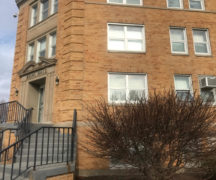By DAVID DUPONT
BG Independent News
As BGSU has developed its engineering programs, plans to build a new facility to house those programs have been in limbo.
The plan has gone from a renovation of the existing 1971 home of the College of Technology, Architecture, and Applied Engineering to the demolition of the 53,000-square-foot facility to make room for a new building.
At Thursday’s session the BGSU trustees approved spending $24.3 million to construct the Technology Engineering Innovation Center. The plan splits the difference between earlier proposals by razing the east wing’s southern face and then expanding to the south, and renovating the remainder of the building.
The trustees have already allocated $5.7 million for design and planning services for the project.
Construction is set to begin in fall, but that depends on the state legislature passing and Gov. Mike DeWine signing the state capital budget. BGSU is expecting to spend $20.4 million in state capital dollars on the project. Another $4.1 million will come from private donors.
If that legislative action is delayed, Chief Financial Officer Sheri Stoll said, the project’s start would be delayed. The project is expected to take 18 months to complete.
The new facility will feature open, flexible lab spaces suitable to the new School of Engineering offerings — robotics, electronic and computer engineering, and mechanical and manufacturing engineering.
The current building, which she described as “wonky with a weird split-level design” did not meet those needs. Still the overall structure was considered sound enough for renovation.
President Rodney Rogers said the construction project reflects the growth in STEM programs.
This will support industries in this sector that are moving to the state and region, he said, as well as giving BGSU graduates opportunities for jobs within those industries.
Trustees also approved spending $10.5 million in state capital dollars to upgrade the computer network throughout campus. This is the first phase of a master plan approved in 2023, which is expected to have five phases.
“This is the backbone of our entire IT infrastructure,” Stoll said.
The existing infrastructure is 20-25 years old. The new technology should have a life of about 30 years, Stoll said.
“This is the launching of the development and redevelopment of our STEM corridor” that is called for in the new master plan, she said.
Also, the trustees approved upgrading the existing systems of central chillers, Stoll said.
These are more efficient than having a chiller in each building. The first was built in 2008. Chillers are now located in Olscamp and the former Centrex building.
The $3.9 million project will replace one of two towers in Olscamp and install another chiller in the Centrex building.
April Smucker, associate vice president, planning, construction and campus operations, said in response to a question from trustees, that the chiller that failed was from a different manufacturer than the others, and the replacement will be more durable.
Work on the Olscamp chiller will begin in fall and be completed next summer with installation of the new Centrex chiller beginning right after taking about a year to complete.
The trustees also approved operating for the fiscal year that begin July 1.
The budget call for spending $468,053,963, an increase of about 4.4%. The university projects bringing in $468,053,963, an increase of about 4.4 percent.
The largest expenditure is $197 million spent on employees salaries and benefits. The faculty union negotiated a 3 percent increase in the compensation pool. The university is granting other employees similar increases. Also, the trustees approved a three-year contract with campus police who are represented by the International Union of Police Associations (IUPA), Local 103. That contract calls for a 3-percent pay increase in the first year with 2.5 percent increases in the subsequent two years.
The university also is budgeting a $1.3 million increase in scholarships.
The university expects to bring in $88.4 million in state money for the BG campus. That’s an increase of $3.4 million, or 4% over last year. That amount has been increasing steadily since 2015, when the university received $62.4 million.
The legislature approved a 1-percent increase in state aid this year. That money is allocated based on institution’s ability to retain and graduate students. BGSU has done a better job at that than most other universities.
The revenue projects are based in part on the expectation of a larger first year class, about 85 full-time equivalent students, entering in August, and retaining 83% of the students who entered in fall, 2023.
The most revenue comes from students tuition and fees which are projected to be $226,628,850 , 3.1 percent more than last year.
In material given to trustees, Stoll stated that undergraduate enrollment growth is critical to the future of BGSU.
The university’s strategy to achieve that at a time when the number of high school graduates is declining includes in part offering new in-demand programs and making sure students feel like they belong and can thrive at BGSU.





